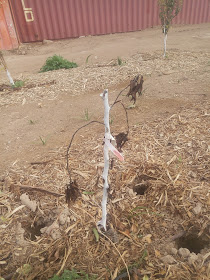A. Frost blankets don't
produce any heat. They capture heat radiated from the soil or other surfaces that
are warmed by the sun and also protects plants from wind. Wind is a partner in
winter damage because warmth radiated from the ground, a nearby wall or even
from the trunk of the plant itself, is lost quickly if there is air movement pushing
it away from its source.
 |
| Sometimes crop covers are stretched over hoops to make low tunnels. |
Depending on their use, sometimes they are called
floating row crop covers, crop covers, row crop covers. They are pretty much
the same but another tool in the “toolbox” for gardeners. These fabric covers
permit air and moisture to move through them but trap heat and disperse high
light intensities.
Some people use plastic sheeting or blankets to protect
the plants from frost damage. They act like wind barriers and insulation. But
frost blankets trap enough heat to keep crops 4 to 5°F warmer during light
freezes. Frost blankets are lightweight, don’t have to be washed and are reusable.
 |
| A difference in germination and seedling growth when a crop cover is used on the right versus no crop cover used on the left. |
I have used frost blankets to cover broccoli, cauliflower
and cabbage during cold winter months if I thought the temperatures were going
to drop dropped really low. These blankets are rolled on top of plants,
stretched over hoops and pinned to the soil so they don't blow away. If left on
during cool, overcast days they push growth more than leaving plants exposed to
the elements. Use them during cool weather, not when temperatures are hot.
They work really well if a few degrees of protection is
needed. But if temperatures get too low. they won't provide enough protection.
Use I use them for
insurance against moderately low temperatures that might cause damaged plants
or when you want to push a little bit of growth during cold weather. They are
available at local nurseries and garden centers as well as online stores. Two
manufacturers of these frost blankets that come to mind are DeWitt and Agribon.Try GrowOrganic.com, Johnny's Seeds, Greenhouse Megastore, Amazon, Park Seed Company, Harris Seeds and other online vendors. Please also check your local nursery. Many of them carry it.
































